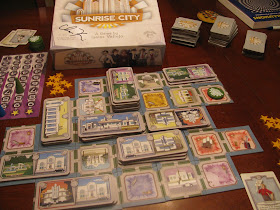I'd first heard of Sunrise City on Chris's Dice Hate Me blog, perhaps August 2011, when it was still in its prototype stage. I was fascinated by both the art and the game concept when I saw it on Kickstarter, but didn't pull the trigger to back it at the time. It's been on my wishlist ever since, though, which is why it didn't take much encouragement for me to pick it up when the opportunity presented itself.
First, the art of this game is just gorgeous. This game has such a unique look to it. I don't know how many times I admired the cover art before I realized that the skyline pictured is actually assymetrical. Chris K. told me that the shapes in the skyline are patterned after the architecture of specific buildings in major cities around the world. This cover really is a work of art.
And the game is substantial. I've admitted previously that even though it's all about the gameplay, I find myself judging a game by the quality of art on the cover and the heft of the box when I first pick it up. SC has both of those qualities in spades. Opening the box reveals just why it's so heavy. The game consists primarily of tiles. The eye-opening components are the 60 huge 6mm-thick chipboard building tiles that are like giant dominoes.
 |
| The art deco influence is strongly evident in every detail of the building tiles - a fact unappreciated by the protest meeple standing his ground on an undeveloped lot |
Our first game is always a learning experience, so Kathy and I were getting the hang of the significance of each of the four phases in the turn. The Preparation Phase involves selecting a "role," such as "developer" or "realtor," which gives some special benefit for the upcoming turn and also determines play order. Interestingly, going first is not always the best option, particularly in the bidding phase, as we learned. The Zoning Phase involves laying out zone tiles in anticipation of where you want to be able to construct buildings later in the turn, so the building tiles that you hold are an important consideration in approaching the Zoning Phase.
 |
| At the end of our first game, Kathy was three points shy of hitting a benchmark and snatching victory from me. Game box autographed by Chris Kirkman |
Points can be scored in the Zoning Phase by placing a zone tile adjacent to another of the same color. Scoring in the Building Phase is based on the "Primary points" value of each building tile placed. On the first floor, controlling an underlying zone allows scoring a half-tile "Bonus points" as well. Buildings can not be placed on zone tiles that are Community Tiles, which instead yield bonus points for building a matching half-tile color on a surrounding tile. Bonus points are also awarded for placing the third, fifth, seventh, etc. floors of an existing building.
The real brilliance of the scoring system, however, is that more points are not always better. In project management, it is important to hit milestones on schedule and on budget. Running over budget and behind schedule are obviously bad, but less obvious is that a project should also not run too far under budget or ahead of schedule. That sounds counter-intuitive, but in fact these cases can mean project planning is inefficient or incomplete. So project managers are motivated to hit their milestones on target.
/pic1300275.jpg) |
| Scoring track and Benchmark tokens: Pass the star, get one - hit the star, get two. Photo: David MacKenzie, Clever Mojo |
I'm a bit prone to analysis paralysis sometimes, so I wonder whether I'm going to overthink this game as we play it more and learn more about it. What I expect will happen, though, is that certain strategies will emerge that define the decision space a little more crisply, and I won't feel the need to think through every possible combination of tile play. Also, my wife keeps me guessing, so sometimes too much planning is counterproductive.
My bottom line is that I really like SC for both its art deco aesthetics and for its unique gameplay and scoring method. I'm really looking forward to the next time Kathy and I can play this, as well as the potential for playing with three or four people at some future date.
/pic1296019.jpg)
No comments:
Post a Comment